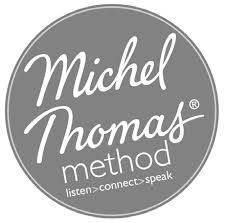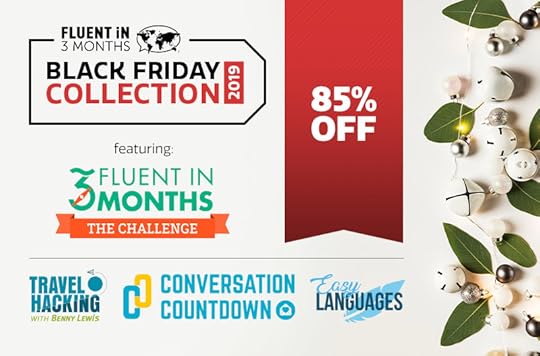Benny Lewis's Blog, page 44
December 26, 2019
“Hello” in Vietnamese: 10 Vietnamese Greetings You Can Start Using Today

When you arrive in Việt Nam, as the native speakers of Vietnamese call it, the first thing you'll want to do is greet your new hosts. That means knowing how to say all the basic pleasantries such as "hello", "nice to meet you", and “how are you?”
On the surface, Vietnamese greetings are actually a pretty simple topic. There aren't a lot of different ways to say "hello" in Vietnamese.
What complicates things is that, in order to know how to say "hello" in Vietnamese correctly, you often need to include the right pronoun (he/she/you) - and in Vietnamese, there are a lot of potential pronouns to choose from.
In this article, I'll teach you all the basic Vietnamese words you need to know to successfully greet people and exchange niceties. I'll also cover the basics of Vietnam's pronoun system, as it's essential for Vietnamese greetings and much else.
Let's start with the most basic Vietnamese greeting that every textbook will teach you first:
"Hello" in Vietnamese - Xin chào
Xin chào is the safest, most polite way of saying "hello" in Vietnamese. You can use it to greet anybody.
It's easy to remember because chào sounds just like the Italian greeting "ciao", which is often used in English. The accent on chào tells you that it's pronounced using the "falling tone". (A full explanation of Vietnamese tones is beyond the scope of this article.)
With chào in our arsenal, it's time to take a brief detour into the bizarre world of Vietnamese pronouns.
Vietnamese Pronouns - a Basic Introduction
One of the strangest things about Vietnamese is that it doesn't really have a word for "you". Yes, really. You'd think that this is quite an important word to have, but somehow the Vietnamese manage without it.
Instead, you address people (and refer to yourself) using familial words like "uncle", "brother", or "grandpa".
These words aren't restricted to your actual family: you use them with everyone, even a stranger on the street. The specific word to use depends on the age, gender, and social status of the person you’re talking to.
So for example, if I want to ask you how you are, and you're a girl slightly younger than me, I could say em có khỏe không?, where em means "younger sibling". To an old man, I would instead say ông có khỏe không? - "how are you, grandpa?" There are many other words to learn.
Here are a few you should know:
em - "younger sibling"; said to someone slightly younger than you
bạn - "friend"; said to someone around the same age as you.
anh - "older brother"; said to a male slightly older than you
chị - "older sister"; said to a female slightly older than you
chú - "uncle"; said to an adult man
cô - "aunt"; said to an adult woman
ông - "grandpa"; said to an elderly man or someone much older than you
bà - "grandma"; said to an elderly woman or someone much older than you
Those are just a few of the most common Vietnamese pronouns, and there are a few more dialectal variations.
If this sounds complicated, that's because it is. But don't worry too much. Vietnamese people won't get offended if you use the wrong word. They know that foreigners struggle with this stuff, and calling someone "grandpa" or asking them their age isn't considered impolite like the way it can be in Western culture.
In fact, if you spend time in Vietnam you'll notice that Vietnamese people tend to ask you bao nhiêu tuổi? ("how old are you?") all the time. They don't mean to be rude; this question is extremely common in Vietnam because people need to know how old you are in order to know which pronoun to use for you.
Another quick note about pronouns: just as Vietnamese has no real word for "you", it also has no real word for "I". Once again, the word you use for "I" depends on who is speaking to you; you use the same word for "I" that they use for "you".
So for example, a young man might say to his girlfriend: anh yêu em ("I love you"), literally "older brother loves younger sibling." The girlfriend might then say back to him em yêu anh - "younger sibling loves older brother". Note how anh means "I" in the first sentence but "you" in the second one.
There are some other ways of saying "I", but we'll worry about them later.
Here's another fun fact about Vietnamese pronouns. You know how in English, we typically refer to people by their title and last name in formal situations? For example, in some situations you might be addressed as "Benny", but in others, you might be called "Mr. Lewis".
Vietnam isn't like this, and they don't really have "titles" in the same way we'd think of them in English. In fact, Vietnamese people don't really use each other's family names at all.
Like in many Asian cultures, Vietnamese names put the family name first and the given name last. So what Westerners call a “last name” is actually a “first name”, if you catch my drift. For the avoidance of doubt, I’ll refer to “family names” and “given names” instead of “first” and “last”.
So, if someone's given name is "Hiển", others might refer to him as "Anh Hiển" - brother Hiển. This is roughly analogous to calling someone "Mr. (Family name)" in English.
I’ve only scratched the surface. The topic of Vietnamese pronouns goes much deeper. But the above should be enough to get started. Let's get back to chào and the question of how to say "hi" in Vietnamese.
“Hello” in Vietnamese Chào bạn/anh/chị
In general, xin chào can sound more formal than necessary. It's more casual to say chào followed by the appropriate pronoun, e.g.:
chào bạn - “hello (person same age as me)”
chào anh - “hello (young man, boy slightly older than me)”
chào chị - “hello (young woman, girl older than me)”
If you want to greet a group of people, you can say chào các bạn - "hello all (my) friends".
By the way, if you're not sure what all those weird accent marks mean on or under words like chị, or why Vietnamese sometimes has twố ằccents ọn the sẩme letter, you need to go back and learn the Vietnamese alphabet. While Vietnamese is difficult to pronounce, the writing system is actually fairly easy to learn. I’ll be publishing an article soon explaining how to read the .
"Good Morning", "Good Afternoon" and "Good Evening" in Vietnamese
If your brain needs a break from juggling all these pronouns, you might want to play it safe with one of these options:
chào buổi sáng means "good morning" in Vietnamese
chào buổi chiều means "good afternoon" in Vietnamese
chào buổi tối means "good evening" in Vietnamese
These greetings aren't as commonly used as a simple chào bạn, but they're still something you should know.
"Hello" (on the phone) in Vietnamese - Á-lô
I can only assume the Vietnamese got this one from the French. When you answer the phone in Vietnamese, you don't say chào but á-lô, just like how in Portuguese you say alô and in French you say allô, all of which are of course derived originally from the English "hello"?
Á-lô is also the kind of thing you might say if the line is patchy and you're not sure if the other person is there. Á-lô, can you hear me?
“Hey!” in Vietnamese - Ơi
Ơi sounds uncomfortably like the British "oi!", which would be a rude way to address a stranger in English.
But in Vietnam, ơi is an extremely common and perfectly polite way to get someone's attention - on the street, in a shop, across the dinner table, or anywhere.
You'd usually preface it with the correct pronoun. For example, you might say anh ơi! to beckon the (male) waiter over in a restaurant.
You can also use ơi with someone's given name. So when Anh Hiển walks into the room, try getting his attention with a Hiển ơi!
“How are you?” in Vietnamese - Khỏe không?
In Vietnamese, to ask someone how they are, what you’re really asking is if they're khỏe - "healthy".
So "how are you?" is khỏe không? ("are you healthy?").
You can also use a slightly longer sentence with a pronoun. For example, you could ask an elderly man ông có khỏe không? ("are you (grandpa) healthy?").
Vietnamese has no exact word for "yes", so in order to reply to a question in the affirmative, you simply repeat the word from the question. So the positive response to khỏe không? is just khỏe! ("(I'm) healthy.").
Không by itself just means "no", so if "grandpa" is not feeling good, the conversation might look like this:
Ông có khỏe không?
Không!
“What’s your name?” in Vietnamese - Tên của bạn là gì? / Bạn tên gì?
An important early step when getting to know someone is learning their name! "Name" in Vietnamese is tên, and to ask for it say tên của bạn là gì? ("name of friend is what?"), or the simpler bạn tên gì?
As I hope you've figured out by now, you'll need to replace bạn in the above examples with the appropriate pronoun for whom you're talking to. So you might instead ask tên của cô là gì? or bà tên gì?
Once you and your conversation partner know each other's names, it might be time to drop this pronoun malarkey altogether. It's common in Vietnamese to refer to yourself and others in the third person, even when it would sound strange to do so in English.
Phưc: Phưc là ngừơi Việt. George là ngừơi Mỹ, phải không?
George: Không phãi, George là ngừơi Anh.
Translation:
Phưc: Phưc is Vietnamese. Is George American?
George: No, George is English.
This style of speech sounds weird to an English speaker, but in Vietnam it's considered friendly and respectful. Plus it means you can take a break from worrying about which pronoun to use.
“Nice to Meet You” in Vietnamese - Rất vui được gặp bạn
After greeting someone, and learning their name (and age), the next thing you might want to do is say rất vui được gặp bạn. This means "nice to meet you!"
Once again, replace bạn with the right pronoun.
“Goodbye” in Vietnamese: Tạm biệt / Hẹn gặp lại
We've covered how to say "hello", but what if you want to say "goodbye" in Vietnamese? The most important phrase to know here is tạm biệt, which means, well, "goodbye"!
Another phrase you might say hẹn gặp lại, which literally means "(I) hope (we) meet again!"
More Ways to Say "I" in Vietnamese
Since knowledge of Vietnamese pronouns is so essential to a knowledge of Vietnamese greetings, I feel it's helpful to end on another quick pronoun-related point.
A ubiquitous pronoun that you absolutely must know is tôi, pronounced “toy”. Most "learn Vietnamese" books will tell you that this word means "I", although its literal meaning is something more like "servant".
As you speak with Vietnamese people, however, you'll quickly learn that tôi is considered a bit too formal for everyday speech. Really, you should refer to yourself as em/anh/chi etc. as described above.
Tôi is the kind of word you use in abstract situations with no specific audience, e.g. writing a newspaper article or addressing a camera.
It's also a word you could use in a crowd if you want to be absolutely clear that you're talking about yourself and not, say, someone else in the room who could conceivably be an em.
của ai? - “whose is this?”
của tôi! - “It’s mine!”
But tôi can still show up in greetings. For example, tôi rất vui được gặp anh ("I'm very pleased to meet you").
Cảm ơn các bạn for reading! (That means "thank you, friends!")
What are the other essential words and phrases for when you first meet someone in Vietnamese? Is there anything I've missed?
And do you have any tips for remembering the vast array of Vietnamese pronouns and knowing which ones to use? (The pronoun topic is much deeper than what I scratched upon here. It really is one of the unusual things about the language.)
Please let us know your thoughts in the comments. And whatever the case, hẹn gặp lại for future articles!
The post appeared first on Fluent in 3 months - Language Hacking and Travel Tips.




December 19, 2019
Language Mentors #8: Johan Tekfak (French Polyglot, Creator of Français Authentique)

“My favorite thing to do in a foreign language is to connect with people. Isn't that what language has been created for?” - Johan Tekfak
What a treat to interview Johan Tekfak for our new Language Mentors series.
If you’ve been studying French for more than a New York minute, you will have seen, read or listened to something by Johan. He’s the founder of Français Authentique. This is a French language learning website which focuses on listening comprehension.
Born in France, Johan speaks French, English and German. And he’s currently learning Italian as a self-taught learner.
After figuring out a way to learn languages in a relaxed manner, he decided to dedicate his time and energy to Français Authentique. His goal is to help people improve their lives by developing their passion.
As a French learner myself, I’ve spent many an afternoon walking while listening to Johan. His podcast series is one of my favorites for listening practice. A lot of his videos center around things that are important to him. Like healthy habits, personal development, and family. And speaking of family, his two kiddos make regular appearances in his videos. They are adorable! In this video, they do the cutest introduction:
httpvh://youtube.com/watch?v=ARmqIGVpKZM
Language Mentors: Learn a New Language in 90 Days
Language Mentors is our popular series where we interview polyglots, language teachers, language learners, and even folks from outside the field of language learning. We’re getting straight to the point, asking for their top tips on language acquisition, steadfast motivation, and rapid learning.
We want to give you the inside scoop on what it takes to learn a new language, fast (in as little as 90 days).
We’ve actually seen hundreds of people learn a new language to a conversational level in just 90 days. You can do it too by putting what you learn from our Language Mentors into practice.
And if you need extra support, then (join us in the Fluent in 3 Months Challenge)(https://add1challenge.com) -- where you’ll make lots of new friends who share your goal of learning a new language fast (plus you’ll have a 15-minute conversation in your new language after 90 days -- we guarantee it).
Read on to learn some of Johan’s language learning hacks. And get to know some fun facts about a creative polyglot at the same time.
What Are the Top Three Activities You Would Advise to Have a 15 Minute Conversation in a New Language after 90 Days?
The first step would be to focus on the basics of the language. Try to understand how it is built. Look at the tenses of the verbs. Figure out how nouns are formed. What do singular nouns look like versus plural nouns? Are there masculine and feminine nouns in your target language?
Listen to as much comprehensible and interesting input as you can. Podcasts, videos, TV shows in your target language are easy to access on your phone or computer.
At the same time, repeat useful sentences over and over to practice speaking.
[caption id="attachment_28404" align="aligncenter" width="1024"]
 In Bratislava with my Slovakian friend, Roman[/caption]
In Bratislava with my Slovakian friend, Roman[/caption]What Are Your Top Three Favorite Places for Studying a New Language?
I prefer to learn in my home office as it is designed to enhance focus and creativity.
My second preferred place is my garden. I feel at home and can benefit from nature at the same time.
A park is the best alternative if I am on a trip.
What Are Your Top Three Favorite Study Tools When You First Start Learning a Language?
I am a little old school in my approach to language learning. This is paradoxical for a guy who is teaching French online.
My favorite tools for studying are a good book, a pen and a piece of paper. Obviously, I also listen to a lot of podcasts and online courses.
What Are Your Top Three Favorite Memories of a Language Win?
Being able to (mostly) understand my drunk Austrian coworkers. They spoke in their local dialect. Understanding that conversation is probably my biggest win.
I will never forget the deep conversation I had with a local while visiting California. We were contemplating the landscape in Yosemite National Park.
I clearly remember my first win in Italian when my family and I were lost in Sirmione. I became my children's hero while speaking Italian with a local.
What Are Your Top Three Favorite Activities to Do in Your Target Languages?
Connecting with people. Isn't that what language has been created for?
Reading a book in its original language.
Listening to podcasts related to personal development.
[caption id="attachment_28405" align="aligncenter" width="1024"]
 In Marrakech with several of my Moroccan online students[/caption]
In Marrakech with several of my Moroccan online students[/caption]What Are Your Top Three Books in a Foreign Language?
How to Stop Worrying and Start Living by Dale Carnegie. I love this book. And I’ve read it several times in four different languages.
The Little Prince by Antoine de Saint-Exupéry is an easy read and a funny tale. It’s available in several foreign languages.
The Monk Who Sold His Ferrari is also a book which has been translated into various languages. It is definitely worth reading.
What Are Your Top Three Favorite Cities?
I love Rome for its architecture, places and historical points of interest.
New York is noisy but amazing. It is grand and personal at the same time. It's the only place I visited that has ever given me this feeling.
Saint-Pierre on the Réunion Island is magnificent with its mountains and amazing views. It’s a jewel in the middle of the Indian ocean.
What Are Three Ways You Keep Yourself Motivated During an Intensive Language Mission?
I try to always remember the purpose of my study. I don't collect languages. I learn them to expand my knowledge and connect with people.
When I lack motivation, I reread The Way of the Linguist by Steve Kaufmann. His practical approach always encourages me.
A tool I use a lot is accountability. I tell the Français Authentique audience what I am doing and what I aim to accomplish. I don't want to disappoint them. So every time I lack the drive to study, I think about the commitment I made to them.
[caption id="attachment_28406" align="aligncenter" width="1024"]
 In Venice with my wife and very good polyglot friend Alberto from Italiano Automatico[/caption]
In Venice with my wife and very good polyglot friend Alberto from Italiano Automatico[/caption]What Are Your Top Three Favorite Language Learning Rituals?
I drink a cup of coffee, play some opera music and read several pages of a book in the language I am studying. It gives me such a lift.
What About You?
Which of Johan’s tips resonate most with you? We’d love to hear about it in the comments section. And to our Fluent in 3 Months participants, best of luck on your language adventure!
Want to learn a new language in 90 days? Come join us in the Fluent in 3 Months Challenge.
A big thank you for Johan for sharing his thoughts and learning secrets with us.
To learn more about Johan and Français Authentique, you can visit his YouTube channel or his website.
The post Language Mentors #8: Johan Tekfak (French Polyglot, Creator of Français Authentique) appeared first on Fluent in 3 months - Language Hacking and Travel Tips.




December 15, 2019
The 10 Best Christmas Gifts for Language Lovers

Want to get them something truly meaningful for their language studies? Something you know they’ll need and that will help them see real progress in their target language? What are the best gifts for language learners?
Fun language-themed trinkets are fun and make great stocking stuffers, but the language learner in your life is sure to make thorough use of the gifts highlighted below.
Gifts for Learners Any Language
The following make the perfect gift for language learners because they work for any language and you’ll be helping your loved one get results fast.
The Fluent in 3 Months Challenge – Have a 15-Minute Conversation in a New Language

The Fluent in 3 Months Challenge is an intensive language program where students are guaranteed to have a 15-minute conversation in their new language after 90 days. It’s a video course with a private community and supportive coaches who encourage you as the course progresses.
Works for: All languages
How to purchase for a friend: The Fluent in 3 Months Challenge only opens for new enrollments a few times each year. If you’d like to pre-purchase an enrollment for a friend or loved one, email support@fi3m.com and we’ll guide you through the process.
italki – Real Conversations with Native Speakers
italki
 is an online language tutoring site with thousands of teachers for hundreds of languages. Many tutors charge around $10 an hour, so lessons are both affordable and with knowledgeable tutors. Lessons are something a language learner can never have enough of, so this gift is always appreciated.
is an online language tutoring site with thousands of teachers for hundreds of languages. Many tutors charge around $10 an hour, so lessons are both affordable and with knowledgeable tutors. Lessons are something a language learner can never have enough of, so this gift is always appreciated.Works for: all languages
How to purchase for a friend: Sign up for italki here and you’ll get $10 of free credit. Once you’ve signed up, you can purchase gift cards.
Gifts to Help Improve Listening & Reading
There are four core skills in language learning – listening, speaking, reading and writing. Listening and reading often go hand-in-hand because they can be practiced together. The following resources make great language learning gifts for the learner looking to improve their listening skills and reading skills in a new language.
LingQ – 1000’s of Hours of Reading and Audio Resources
 Compelling input is an effective way to not only learn a new language, but maintain interest -- and that’s just what LingQ offers. The app includes both audio and reading materials for learners, but where it really shines is with its import feature. Learners can import their own audio, video, and reading materials, then use LingQ’s tools to learn new words and phrases.
Compelling input is an effective way to not only learn a new language, but maintain interest -- and that’s just what LingQ offers. The app includes both audio and reading materials for learners, but where it really shines is with its import feature. Learners can import their own audio, video, and reading materials, then use LingQ’s tools to learn new words and phrases.Works for: 24+ languages
How to purchase for a friend: You can get LingQ Gift Certificate (3, 6 and 12 month options available) here. After purchasing, you will receive an email with a coupon code you can share with the user you wish to gift the membership to.
Pimsleur – Call and Response Audio
 Pimsleur is an audio resource that uses call-and-response to assist learners looking to improve their listening and speaking. The new subscription version of Pimsleur also includes reading materials, flashcards, games and more in addition to the well-known audio course. The audio course features a narrator who prompts you to respond at the appropriate moments as well as two or more native speakers you interact with and model your speaking after.
Pimsleur is an audio resource that uses call-and-response to assist learners looking to improve their listening and speaking. The new subscription version of Pimsleur also includes reading materials, flashcards, games and more in addition to the well-known audio course. The audio course features a narrator who prompts you to respond at the appropriate moments as well as two or more native speakers you interact with and model your speaking after.Works for: more than 50 languages
How to purchase for a friend: Once you start the purchase process for a Pimsleur course, you’ll be able to mark it as a gift. You can also purchase an e-Gift certificate so they can choose a course on their own.
Michel Thomas – An Easy Way to Learn a New Language, Fast
 Michel Thomas is another call-and-response style audio course developed by Michel Thomas. In this course, you learn alongside two students and a teacher. It goes into detail on the language and its grammar as well as teaching new words.
Michel Thomas is another call-and-response style audio course developed by Michel Thomas. In this course, you learn alongside two students and a teacher. It goes into detail on the language and its grammar as well as teaching new words.Works for: 18+ languages
How to purchase for a friend: You can order Michel Thomas courses direct from Amazon.
Get Michel Thomas Spanish here
Get Michel Thomas French here
Get Michel Thomas German here
Get Michel Thomas Italian here
All other Michel Thomas courses here
Mimic Method – Unlock the “Sound System” of Your Target Language
The Mimic Method
 is a pronunciation course that goes into great detail on how to recognize and produce the sounds of a language. It has several training exercises and more to help you improve your pronunciation and accent in a language.
is a pronunciation course that goes into great detail on how to recognize and produce the sounds of a language. It has several training exercises and more to help you improve your pronunciation and accent in a language.Works for: Spanish, French, German, Russian, Portuguese, English, Chinese, Italian, Japanese
How to purchase for a friend: Upon purchasing the course, contact Mimic Method with the email address of the recipient so that they can register them for the course.
Innovative Languages – Podcast Language Courses
 Innovative Languages is best known for their Pod101 and Class101 series in a wide range of languages. It is an audio course with hundreds of 10-20 minute lessons and additional study aids such as flashcards and audio transcripts.
Innovative Languages is best known for their Pod101 and Class101 series in a wide range of languages. It is an audio course with hundreds of 10-20 minute lessons and additional study aids such as flashcards and audio transcripts.Works for: 40+ languages
Gifts to Help Improve Grammar & Vocabulary
Building a strong foundation in a language with grammar and vocabulary is key to any language learner’s success. Here are the best language learning gifts to help them do just that.
Olly Richards’ Uncovered Series




The Uncovered series from Olly Richard’s is an in-depth grammar course that helps you get from a beginning level in the language to intermediate. The courses are taught with native speakers and use a variety of exercises to help you master key grammar.
Works for: Spanish, Italian, French, German
How to purchase for a friend: When purchasing the course, enter the gift receiver’s name and email in the contact information.
Get Spanish Uncovered here
Get French Uncovered here
Get Italian Uncovered here
Get Japanese Uncovered here
Drops
 Drops is a visual language learning app that teaches vocabulary using gameplay. It’s my favorite way to learn new words (full disclosure: I also work for them) because it just takes 5-minutes a day and I can study thousands of words in any of more than one hundred topics.
Drops is a visual language learning app that teaches vocabulary using gameplay. It’s my favorite way to learn new words (full disclosure: I also work for them) because it just takes 5-minutes a day and I can study thousands of words in any of more than one hundred topics.Works for: 35+ languages
How to purchase for a friend: Purchase Drops Premium as a gift here.
MosaLingua
MosaLingua
 is another vocabulary learning tool that uses SRS to help you learn new vocabulary. It also has a feature you can use to study entire dialogues.
is another vocabulary learning tool that uses SRS to help you learn new vocabulary. It also has a feature you can use to study entire dialogues.Works for: Italian, Spanish, French, German, Brazilian Portuguese, English and Russian
How to purchase for a friend: You can purchase your friend a one-year subscription to MosaLingua as a giftcard.
What about you?
What language learning gifts do you plan to give this holiday season? Any in particular you would like to receive? Let us know in the comments below!
The post The 10 Best Christmas Gifts for Language Lovers appeared first on Fluent in 3 months - Language Hacking and Travel Tips.




December 12, 2019
20 Russian Slang Words To Help You Speak Like A Local

1. Бабки [babki] - “Money”
The literal, somewhat rude meaning is “grandmas”, but the actual meaning is usually “money” or “bucks”. Here’s an example:
Бабки есть? [Babki yest'?] - “Got some money?”
This word is mostly used in casual talk, so you will never hear it from someone speaking in an official manner. In fact, the word бабки is also used by criminals both large and small. If you watch some modern Russian movies or TV shows, you will notice that the majority of law-breakers use this word for money rather than using the usual деньги [den'gi] .
2. Тусить [tusit'] - “To hang out”
The word тусить doesn't have a literal meaning and is always used as a verb that means “to hang out” or “to party”.
Мы тусим. [My tusim] - “We're hanging out.”
Most Russians love hanging out with their friends or family. The word тусить can be used in almost any situation to describe the action of hanging out with other people, but you should still keep in mind that it's a slang word.
3. Чувак/Чувиха [chuvak/chuviha] - “Dude”
Чувак and чувиха literally mean “dude” and “dudette”. Чувак can also mean “guy”, “pal”, “mate”, and so on, while чувиха can also mean “gal”.
Чувак со мной работает. [Chuvak so mnoy rabotaet.] - “The guy works with me.”
The feminine version of the word dates back to the 1920s, but during that time, it meant “prostitute”. It went more mainstream during the 1960s and has since become a common slang word along with its masculine counterpart.
4. Чёрт [chiort] - “Devil”
The literal meaning of чёрт is “devil”, but it is more commonly used as an exclamation similar to “Shoot!” or “Damn!”
Чёрт, я забыла об этом. [Chiort, ya zabyla ob atom.] - “Shoot, I forgot about it.”
The word чёрт is used both by young and old alike. It is not a swear word, so you will hear people often exclaiming that just like English-speakers use “damn” or “shoot” in unfortunate situations.
5. Хавать [havat'] - “To eat”
The word хавать only has one meaning - “to eat”. But this verb takes on a more casual form as it is a slang word.
Идём хавать. [Idiom havat'.] - “Let's go eat.”
There are many synonyms in the English language that mean the same thing - “to eat”. They include: grub, pig out, chow down, and others. As long as it's a casual word or phrase for eating, its equivalent will probably be хавать in Russian.
6. Бухать [buhat'] - “To drink”
Unlike English, the Russian language actually has a slang word for the verb “to drink” and this word is бухать.
Пошли бухнём. [Poshli buhniom.] - “Let's go drink.”
There are some other variations that have the same base including бухой [buhoy] (“drunk”) and набухаться [nabuhatsa] (“to get drunk”).
7. Грузить [gruzit'] - “To bore with too much talking”
Literally, it means “to load”, but as a slang word, грузить means “to overload mentally” or “to bore with too much talking” or “to confuse”.
Хватит меня грузить! [Hvatit menia gruzit'!] - “Stop overloading me!”
When someone keeps boring you with their long and endless story or tries to load you with their troubles, you can always use the word грузить to express how you feel and ask them to stop.
8. Бомба [bomba] - “Amazing”
This word is very similar to the English word “bomb” and they actually have the same meaning. However, бомба also means “the bomb” or “amazing” when used casually.
Это место просто бомба! [Ato mesto prosto bomba!] - “This place is the bomb!”
More often than not, using this word to show your awe of something will express your feelings quite well as it is best applied in situations when you've been blown away (in a good sense). By the way, did you know that Russian is one of the most popular, Бомба languages in the world?
9. Достал/Достала [dostal/dostala] - “To be annoyed”
The literal meaning of this verb is “to reach over and get”, but the slang form is just as common and means “to be annoyed”.
Ты меня достал! [Ty menia dostal!] - “You've annoyed me!”
By using this verb, you can show that someone has annoyed or irritated you quite a bit.
10. Всё ништяк. [Vsio nishtiak.] - “It's all good.”
“When I went to Russia, I couldn't understand what this phrase meant at first. But once they explained it to me, I started using it more often in my daily conversations. “It's a really fun phrase,” says Neightan White, travel blogger from IsAccurate.
The phrase всё ништяк is the equivalent of the phrase “it's all good”, but the Russian version has a more casual tone to it.
Я разобрался. Всё ништяк. [Ya razobralsia. Vsio nishtiak.] - “I've figured it out. It's all good.”
Use this phrase to show that everything is fine and you are feeling good.
11. Мне до лампочки. [Mne do lampochki.] - “I don't care.”
If you take it literally, it won't make any sense as it means “to me to the lightbulb”. But this phrase actually means “I don't care”.
Мне до лампочки, придёт он или нет. [Mne do lampochki, pridiot on ili net.] - “I don't care whether he comes or not.”
You could say that this is a very expressive way to show your indifference to something.
12. Мне фиолетово. [Mne fioletovo.] - “I don't care.”
This phrase is very similar to the previous one and actually has the same meaning.
Да мне фиолетово вообще. [Da mne fioletovo voobshe.] - “I don't really care.”
You can use this phrase and мне до лампочки interchangeably.
13. Офигеть! [Ofiget'!] - “Wow!”
There is no literal meaning for this word, but it means something along the lines of “wow” or “I can't believe it”.
Офигеть! Никогда не ожидала. [Ofiget'! Nikogda ne ozhidala.] - “Wow! I never expected that.”
There is a Russian word фига [figa] that originated from a similar word in German and was the equivalent of the English F-word. Офигеть is just one of the many words that spawned from the word фига and are now widely used all across Russia and some other neighboring countries.
14. Кайфонуть [Kayfonut'] - “To have a pleasant pastime”
This verb originates from the word кайф [kayf] which is a slang term for “pleasure”. Consequently, кайфонуть means “to have a pleasant pastime”.
Я кайфонул. [Ya kayfonul.] - “I had a nice time.” or “I enjoyed myself.”
Originally, this word was used to describe the state one experiences being on drugs, but then its meaning transformed into a more acceptable one. You can use it for anything from enjoying chocolate to having a good time hiking. Try using it during a language exchange.
15. Давай побазарим! [Davay pobazarim!] - “Let's have a chat.”
Literally, you could say this means “let's do marketing”. However, the actual meaning is something along the lines of “let's have a chat”.
Давай выйдем, побазарим. [Davay vyidem, pobazarim.] - “ Let's go out, have a chat.”
More often than not, you will hear this phrase used by criminals, though normal casual chats may also have it here and there.
16. Да не гони! [Da ne goni!] - “Seriously?”
You would think that this phrase means “don't go/drive fast”, but it actually has four other meanings similar to each other.
Да не гони! Серьёзно? [Da ne goni! Seryozno?]- “I can't believe you! Seriously?”
The meanings vary from “you are saying something unreal” and “I don't/can't believe you” to “you are saying something I believe is not true” and “stop lying”.
17. Да ну нафиг! [Da nu nafig!] - “ I don't want it.”
As you may have noticed, this is one of the variations with the word фига. The phrase means “I don't want it” or “‘eff it”.
Да ну нафиг! Не буду я это делать! [Da nu nafig! Ne budu ya ato delat'!] - ”’Eff it! I won't do it!”
You could also extend the meaning to “‘eff it, I don't want to deal with it”.
18. Нифига себе! [Nifiga sebe!]- “Wow!”
Yet another useful variation of the aforementioned word, нифига себе is actually quite similar to офигеть and means is used to show your “wow” reaction to something.
Нифига себе! Он это реально сделал! [Nifiga sebe! On ato real'no sdelal!] - “Wow! He really did it!”
You can use this phrase every time you are awed or surprised by something, but if you are looking for a less striking phrase, ничего себе [nichevo sebe] is a nice alternative.
19. Это полный зашквар! [Ato polnyi zashkvar!] - “This is too much.”
This phrase could be used both for saying “this is too much” and for saying “this is insane”. However, the first definition is more widespread.
Это полный зашквар! Я не знаю, что делать. [Ato polnyi zashkvar! Ya ne znayu shot delat'.] - “This is too much! I don't know what to do.”
You can also say it to somebody who did something insane, overdone, or complicated.
20. Ты спалился! [Ty spalilsia!]- “You got spotted!”
The last word on our list literally means “you burned yourself”, but that's actually not what it is used for. Ты спалился is the equivalent of “you've been busted” or “you got spotted”.
Ты спалился на экзамене. [Ty spalilsia na ekzamene.] - “You were busted on the exam.”
More often than not, you will use it to say that you saw someone or another person saw someone doing something they weren't supposed to be doing (like watching movies when you should be studying for the exam).
Final Thoughts on Russian Slang
All in all, using Russian slang words will not only allow you to sound more natural but will also help you understand songs, movies, and other types of entertainment. This is definitely not a complete list of all the Russian slang words you may encounter while having conversations with Russians, but these twenty are the most commonly used ones and you can start learning them first.
The post 20 Russian Slang Words To Help You Speak Like A Local appeared first on Fluent in 3 months - Language Hacking and Travel Tips.




December 9, 2019
How to say “I Love You” in Japanese (and 50+ More Ways to Share the Love in Japanese)

Or maybe you want to learn how to say “I love you” in Japanese just in case you fall in love while traveling abroad. Maybe you want to understand those gushy scenes in shoujo anime.
Or, you’re interested in having a deeper cultural knowledge and understanding of how Japanese people express love and affection.
No matter what your reasons, this is a great topic to learn.
For one, it’s always good to know how to properly express your appreciation and affection in any language and culture. It feels good to make others feel good! But this particular topic offers a lot of insight into the differences between Western cultures and Japanese culture.
So, how do you say “love” in Japanese?
How to Say “Love” in Japanese
“Love” is either 愛 (ai) or 恋 (koi). In verb form, “to love,” you add the verb “to do” which is する (suru). So they become 愛する and 恋する.
What’s the difference between ai and koi?
Ai refers to the love of a person, a romantic love. Koi is a more general feeling of love, and describes the feeling itself. The difference is pretty subtle.
Some other synonyms you should know:
愛情 (aijou) - Affection
愛情表現 (aijou hyougen) - Love expressions
愛着 (aichaku) - Attachment
愛でる (mederu) - Admire
想い (omoi) - Sentiment, desire
愛の告白 (ai no kokuhaku) - Love confession
Lastly, there’s an informal way to talk about love, which is ラブラブ (rabu rabu). It means “lovey-dovey,” and you’ll often hear it used to talk about couples who are rabu rabu and still in the ハネムーン (hanemu-n, “honeymoon”) stage.
How to Say “I Love You” in Japanese
If you want the direct translation, “I love you” in Japanese is 愛してる (aishiteru). But, in Japanese culture, expressing love and affection isn’t very common. This phrase may be said only a handful of times between a husband and a wife during their life (usually during a proposal or marriage). 愛してる is considered a “heavy” sentiment, almost too intense and dramatic.
If you’ve ever heard of the 5 love languages, then this may be the best way to explain it from a Western perspective. One of the love languages is ”affectionate words”, such as telling your partner that you love them.
In Japan, instead of expressing love with affectionate words, it’s more common to express love through actions, kind gestures, and gift-giving. Japanese culture values loyalty, consistency, and caring actions above all else. This is considered so important that some couples may admit they’ve never even expressed “I love you” verbally to anyone before. It’s becoming more common in younger generations but it’s still not used often. Don’t be mislead by dramas and anime, which romanticize relationships more than real life (what TV show doesn’t, though?).
Remember, Japanese is not a direct language. They’re more likely to say chotto (“a little bit”) than iie (“no”) because “no” is too direct. The same is true for expressing feelings. Japanese people don’t want to use “love” lightly, and they don’t think it feels natural to express such strong feelings. Of course, there are exceptions, but as a whole, phrases like aishiteru are saved for TV and marriage proposals.
If you want to let someone know you care, it’s far more common to say 好きだよ (suki da yo) if you’re a guy or 好きよ (suki yo) if you’re a woman. This actually translates to “I like you” -- quite a lukewarm statement in English, but an appropriate one for Japanese.
There are some regional differences, too. The most common one you may hear is Kansai-ben, the dialect from Osaka. In Kansai-ben, you would say 好きやねん (suki yanen).
How to Say “I Love” in Japanese
If you’re in a committed relationship, you can bump it up a notch to 大好きだよ (daisuki da yo), which is “I really like/love you.” The word daisuki in Japanese combines the kanji for “big” (大) and “like” 好き (like) to mean you have strong affection or interest in something.
But daisuki can be used to say “I love” ... anything! Just like how we overuse the word “love” for everything in English, you can use daisuki in the same way. For example, you can say “I love books” with 本が大好きです (Hon ga daisuki desu).
In casual speech, you can drop the particle ga and verb ending desu to exclaim 本、大好き! (Hon, daisuki!) It’s closer to saying, “Ah, books! I love them!”
As you can see, daisuki has varying levels of “love” just like how we use it in English to describe many kinds of love. One thing to note is -- when said to another person -- daisuki doesn’t always mean “I really like you” or “I really love you.” Sometimes, it just means “I really enjoy spending time with you.”
Which, let’s be honest, is a much less intense way to express affection than “I love you.”
What if you’re in a situation where you’re expressing love or someone else is expressing it to you in Japanese? Keep in mind that using daisuki doesn’t always mean a love confession. You’ll have to use contextual clues and the other person’s actions to determine intensity.
And in case you’re wondering about text shorthand like “I love u” in Japanese, or even “ily” ... Well, you won’t find an exact equivalent. Japanese has a lot of text shorthand like we do in English, but “I love u” isn’t one of them. It’s more common to send cute stickers (like what we have on Facebook) that say things like すき (suki, “like”), ドキドキ (dokidoki, Japanese onomatopoeia for “heart racing”) and 幸せ (shiawase, “happy”).
How to Say “Cute” in Japanese
“Cute” in Japanese is かわいい (kawaii). In Japan, everything is cute. You’ll hear this phrase all the time for women, children, and objects.
You wouldn’t normally call a man かわいい. Instead, you might call him かっこいい (kakkoii, “cool” or “handsome”) or イケメン (ikemen). Ikemen is a word combining ikeru (“cool”) and menzu (“men”).
How to Say “Beauty” in Japanese
If you wanted to say “beauty” in Japanese as a noun, you would say 美しさ (utsukushisa). But to describe someone or something as beautiful, you can say 美しい (utsukushii). This word is a bit heavy, though, like aishiteru. So utsukushii is usually reserved for beautiful things, especially in nature, such as when the cherry blossoms bloom.
When telling someone they look nice, it’s common to say 素敵な (suteki na), which means “lovely.” You can be more casual by saying ステキー! (suteki-, but drawn out and written in katakana).
You could also use きれいな (kirei na) for “pretty,” which is appropriate for any situation.
How to Say “Sexy” in Japanese
“Sexy” in Japanese is taken from English and written as セクシー (sekushi-). Sometimes you’ll hear 色っぽい (iroppoi) which literally means something like “colorful-ish,” but translates as “sexy,” “sensual,” or “erotic.” It’s often used to talk about older women.
How to Say “Heart” in Japanese
There are three words for “heart” in Japanese: 心 (kokoro), 心臓 (shinzou), and ハート (ha-to). Shinzou refers to your physical heart inside your chest. Ha-to is taken from English to describe the symbol of a heart. Finally, kokoro is used to describe the emotional heart. Kokoro is a word that connects the mind, heart, and soul into one word. It captures the essence of all the emotions you can feel.
Unlike many other languages, there aren’t a ton of romantic phrases using “heart” in Japanese that you’ll actually hear in everyday life. While it’s romantic to say things like mi corazón in Spanish, or “my heart beats for you” in English, there really isn’t a phrase like this in Japanese. It’d be too heavy. Kokoro is more a metaphysical sense of being than an expression of love.
However, if you want to talk about being heartbroken, you could say:
心を壊れています (kokoro wo kowarete imasu): My heart is breaking
失恋 (shitsuren): Heartbroken (unrequited love)
がっくり (gakkuri): Heartbroken, miserable
How to Talk about Your Boyfriend in Japanese
Girls love to be cute with their boyfriends in Japanese! You’ll often hear girls shorten the name of their loved one, and add -ちゃん (-chan) or -くん (-kun). For instance, if your boyfriend’s name is Kaito, you would call him Kai-chan or Kai-kun. Either is cutesy, but for those new to Japanese honorifics, -chan is used more for girls and -kun for boys. The exception is usually children or when a girl wants to sound extra cute. Then she may call a boy or boyfriend -chan.
When talking about your boyfriend, you can call him either 彼氏 (kareshi), 彼 (kare) or ボーイフレンド (bo-ifurendo). Any of those are fine, but when you want to say, “I have a boyfriend,” it’s 彼氏がいます (Kareshi ga imasu). And if you want to talk about an ex-boyfriend, it’s 元カレ (motokare).
If you’re already married, your husband is 夫 (otto) when talking to others. When talking to your husband directly, you can call him 旦那さん (dannasan) to sound cute.
How to Talk about Your Girlfriend in Japanese
“Girlfriend” in Japanese is either 彼女 (kanojo) or ガールフレンド (ga-rufurendo). And ex-girlfriend is 元カノ (motokano).
And to say you have a girlfriend, it’s 彼女がいます (kanojo ga imasu).
Unlike when girls talk about their boyfriends, guys won’t usually call their girlfriends by a cute name or add a suffix. Instead, to show affection and intimacy, they’ll just call them by their first name without honorifics. So if your girlfriend’s name is Minako, you might call her just “Minako” or shorten it to “Mina.” Men don’t want to add cuteness when they’re speaking, so this is the best way to show affection. Women can call their significant others by their first names, too, but it’s far less common. It seems to be heard more often among the younger generation now.
When talking about your wife, you can call her 妻 (tsuma) or 奥さん (okusan) when talking to others. When talking to her, you can be sweet and say 嫁 (yome, "bride") or call her ダーリン (da-rin, “darling”).
For both men and women, you can say you’re married with 結婚しています (*kekkon shite imasu).
How to Talk about Your Friends and Family in Japanese
So when talking about your friends and family, how do you express affection?
Well, just like in romantic relationships, you would express your feelings through actions and loyalty. But, you can tell your family 大好き (daisuki) to say you love them. Just don’t overuse it -- it isn’t said every day, if at all. It’s most often said between young children and their parents, and then it isn’t said anymore after they grow older. But it depends on the family and their personalities, too.
You would never tell your friends that, though. It’d be very strange to tell a friend that you really like them! Instead, you could call them your 大切な友達 (taisetsu na tomodachi), “important friend.” Online, you could tag a BFF with ずっ友 (zuttomo, “forever friend”), but this is only インターネットスラング (inta-netto surangu, “internet slang”).
In general, it’s more common to express gratitude instead of love to family and friends for all they do. (あなた)がすることすべてに感謝します ((Anata) ga suru koto subete ni kansha shimasu, “I appreciate all you do.”) will work -- just replace anata with the person’s name.
How to Talk about Feelings in Japanese
So we’ve talked about how you shouldn’t be very open about expressing strong feelings in Japanese. But how would you start making a move?
Here are a few phrases to level up your relationship:
今度一緒にデートしない? (Kondo issho ni de-to shinai) - Would you like to go on a date sometime?
付き合ってください (Tsukiatte kudasai) - Will you be my girlfriend/boyfriend? (Literally: “Please associate with (only) me.”)
結婚してくれる? (Kekkon shite kureru) - Will you marry me?
Share the Love in Japanese
There’s your crash course how to say “I love you” in Japanese! How will you practice it? Are you going out to look for your soulmate in Japan and profess your love?
Are there any romantic phrases I missed? Share them in the comments with me!
The post How to say “I Love You” in Japanese (and 50+ More Ways to Share the Love in Japanese) appeared first on Fluent in 3 months - Language Hacking and Travel Tips.




December 5, 2019
Spanish in 3 Months: Mission Complete! (with Video!)
Fluent in 3 Months team member Elizabeth is learning Spanish from scratch over just 90 days. In this final update, she’s sharing the insights she’s found during the third month of learning Spanish, plus a video of her progress on Day 90. Take it away, Elizabeth.
If you haven’t read the other articles about this mission, here are the links:
Planning
Day 0
Day 30
Day 60
The Bottom Line: My Results Are Remarkable
Let’s face it. No one is going to make a full-length movie out of my three month mission. No one will be banging down my door to beg me to give a keynote speech on perfect language learning. My results are not newsworthy.
But my results are remarkable. They are remarkable to every person I’ve met whose eyes soften when they say, “Oh, I’ve always wanted to learn Italian (or French, or Swahili or some other beautiful tongue).”
They are remarkable to my husband who brags about me when he doesn’t think I’m within earshot. “She’s learning Spanish. She has actual conversations in Spanish!”
They are remarkable to my best friend who shows her 12 year old daughter my progress videos. “See? If your aunt can learn a language, you can learn French.”
My ability to have a conversation completely in Spanish in under 90 days is remarkable to me. You see, I tried and failed 10 times before finding Benny Lewis, the creator of Fluent in Three Months.
Lots of money shelled out. Lots of time invested. But no Spanish speaking ability. Until now.
How Exactly Did I Do It?
A lot of people have the same burning question. How did I do it? How does someone manage to have a 15 minute conversation in 90 days?
The previous articles about this mission offer the specifics of how I reached my goal. This article will spell out the progress I made in 90 days. If you’re dying to see my 90 Day video, scroll down the end of this article.
Solo Learning Vs the Fi3M Challenge
Two years ago, I started teaching myself French. Three months ago, I started learning Spanish with the Fluent in 3 Months Challenge
Let’s compare apples to pears or rather croissants to tacos. Here are the differences between learning French as a solo learner and learning Spanish as a Fluent in 3 Months Challenger.
Community is key to keeping doubt at bay. I started French as an autodidact without a language learning tribe. Non-Fi3M compared to the Fluent in 3 Months Challenge? It was tough going.
In the Fluent in 3 Months Challenge online community, I shared my wins which might sound minuscule to someone not in the trenches. But the Challenge participants get what a big deal it is to have a three sentence conversation with a shopkeeper.
I learned to lean into my discomfort. Surrounded by my fellow challengers, I was not alone. Others had done this before us. We did it together.
I Reached a Good Level of Listening Comprehension 4x Faster
I worked within the structure of the Fluent in 3 Months Challenge. Because of this, my listening comprehension reached a good level four times faster compared to when I learned French solo. This happened for a number of reasons.
I Had a Clear Goal
I wanted to have a 15 minute conversation in Spanish. That meant I needed to understand what the other person was saying to me. I immediately jumped into listening comprehension practice by using LingQ daily.
Within 90 days, my Spanish listening comprehension matched that of my French after a year of learning!
I Asked Questions in the Fluent in 3 Months Challenge Community
There are many repeat challengers and seasoned polyglots in the challenge. I got some great ideas from them. I connected with the Fi3M online community to help me when I was feeling unmotivated or lost.
Those two hard-to-measure emotions stop countless language learners in their tracks. Many solo learners have never recovered. I would know! Those gremlins thwarted my language learning for most of my life.
I Learned from Past Mistakes
The Fi3M Challenge reminded me of the typical pitfalls of language learning. I was able to steer clear of them. The assignments kept me from slipping into no-growth ruts.
Here’s a quick breakdown of my three month Spanish mission as it relates to my listening comprehension.
I understand the basic plot of a TV show without subtitles.
I understand 80% of what my three teachers say to me.
I understand 65% of small talk conversations I have with native speakers.
I understand 0% of what a fast native speaker is saying if I get nervous.
Speaking Ability Was Two times Faster
Because I am a fan of speak from day one, this skill was practiced early on in my French solo learning. Yet the acquisition of this skill was two times faster when learning Spanish with the Fi3M Challenge. Why?
The Fi3M Challenge Got Me Speaking More Often than I Did As a Solo Learner
Once a week, I would meet with my Dream Team where we took turns deciding on topics to discuss. The assignments helped me prepare for my lessons with italki tutors.
Group Accountability was a Big Help
This community picked me up when my brain was fried and my enthusiasm was a runny omelette of shoulds.
I got warm fuzzies whenever someone who had a Nay yesterday mustered up a Yay the following day. Those silly emojis of support are quite effective.
Mini-challenges Made Sure I Was On Target For My 15 minute Conversation in Spanish
With all the steady support in place, I found speaking practice to be a rewarding activity from the start.
Here’s a breakdown of my three month Spanish mission as it relates to my listening comprehension.
99% of the time, people are surprised that I’ve been learning Spanish for less than three months.
98% of the time, my teachers understand the ideas that I’m attempting to convey.
100% of the time, my American accent thickens when I get nervous or excited.
How Much Learning Time Did I Put into Spanish?
[table of learning list]
I Practice Speaking from Day One
As you can see from the table, I had a steady flow of speaking practice. I scheduled lessons bi-weekly and sometimes as much as three times a week.
I usually have my lessons in the wee hours of the morning before my work day begins. My tutors have seen me with bedhead and sleepy eyes. I tiptoe through the house to chat via Skype in my living room.
I have a few reasons for speaking from day one.
I Lose Motivation if I Don’t Start Speaking
Speaking from day one helps me feel connected to native speakers. It’s instant gratification.
Nothing keeps me as motivated as laughing with my teacher. When I make up words or manage to explain a silly story in Spanish, it's golden.
Someone recently asked me how I speak from day one if I don’t understand anything. I like to work with teachers that use images. I use some techniques mentioned in this YouTube video.
I’m Not a Big Fan of Studying or Homework
I pick up a lot of beginner grammar while simply chatting, listening and reading.
You don’t need to spend as much cash as I did for tutors. I was on a tighter budget when I learned French. Language exchanges are free and fun.
I Listen to Interesting Content Daily
In one of my other updates, I talked about creating space for language learning in my daily routine. When people ask how I practice listening, images of soapy dishwasher flood my brain.
Why? Because I listen to Spanish every morning while washing my dishes.
You’d never think I’d be elated to get a set of dishpan hands. This chica loves to find ways to peacefully multitask. Here are a few of my favorite times for listening practice.
Washing dishes
Commuting
Exercising
During meditation I listen to guided meditations in Spanish. Hat tip to Kerstin Cable of The Fluent Show for sharing about Insight Timer on one of her podcast episodes.
Chopping veggies
Hanging out in a waiting room
Doing any mundane task
I’m a Natural Bookworm
You’ll notice there are a lot of measurements for my reading skills. That’s because it’s very easy to measure. It’s satisfying to finish reading your first book in a target language.
I completed my first book a few weeks after the Challenge. It felt great when I could add that to my target language list of accomplishments.
I Did a Minimal Amount of Grammar
I’m working my way through Spanish Uncovered which is an enjoyable course. It’s a meaty curriculum.
I’m glad I can work it at my own pace. I’m surprised at how often I appreciate the exercises. Each chapter is like a puzzle to unlock.
I Wrote in My Target Language from Time to Time
Writing is also not one of my most pressing goals at the moment. I’m interested in speaking with Spanish speakers. I don’t have a huge desire to write in my target language yet.
However, writing out a few scripts for my Dream Team meetings was helpful for our discussions. I wrote simple sentences for things like my introduction and my language tools.
Getting out of My Comfort Zone Was the Key to My Progress
Having the Fi3M structure to move me out of my comfort zone was the secret to cutting my learning time in half. I focused on doing the challenge as it was. I didn’t try to find an easier, faster way.
The Group Dynamic Kept Me Going
Outside of the structure, it’s difficult to explain the wave of energy within the Fi3M Challenge. I do well with accountability when it’s practiced in a positive way. And the community of the Fi3M Challenge provided me with that.
I’m not saying this Challenge is the only way to get that community. It’s just the fastest and most steady way I’ve found. And the electricity that comes from everyone working on the same goal was a game-changer for me.
If you meet me in one of the future Fi3M Challenges, don’t mind my happy puppy energy. My enthusiasm is hard to contain. Why? Because I know that if it worked for me, it can work for you.
Spanish in 3 Months: My Final Mission Video
My Day 90 video was supposed to be 15 minutes long. It ended up being 45 minutes long. I kept the camera rolling so that you could see what a lesson looks like when it’s completely in the target language. My teacher, Emanuel, is talented at keeping the lesson in Spanish.
//www.youtube.com/watch?v=S5_g-382tO8
I showed this video to my French language exchange partner a few days ago. He asked me with a wry smile, “It’s a good video. But you planned what you were going to say, right?” That gentle suspicion was the best compliment anyone has ever given me.
I had no idea what specific questions Emanuel would ask me. It looks like he wrote down a few to keep us on track. Before the recording, I told him that I’d like to talk about the subject of language learning and the tools that I use.
During the Challenge, we practiced having a 15 minute conversation at the beginning of every lesson. We talked about what we did that week, travel and language learning. So, I did practice talking about the topic of language learning from time to time.
If you look closely, you can see my lips pierce into a tiny little bow every time he asks a question. I was quite nervous. Remember, I’ve never had a three month language mission before now.
What’s Next?
I plan on continuing my trek to fluency in Spanish. I signed up for another Fi3M Challenge. I will be focusing on improving my listening comprehension. I’d also like to get a handle on the present and simple past tenses.
Thanks for joining me along the way. Your kind words of support were greatly appreciated. And the real gold here? If this language learning drop-out can learn Spanish, you can do it, too. I hope you found my Spanish journey helpful. If you missed some of the earlier articles, here’s a recap.
The tools I used to learn Spanish
How I fit language learning into my daily routine
What I look for in an online tutor
How to study while traveling
Are you planning on embarking on a language mission? Have you already succeeded in one?
Let us know in the comments! We’d love to know what you’re up to. After all, we are always on the lookout for the next language mission.
Wishing each and everyone one of you happy language learning!
The post Spanish in 3 Months: Mission Complete! (with Video!) appeared first on Fluent in 3 months - Language Hacking and Travel Tips.




November 24, 2019
Black Friday Mega-Deals for Language Learners 2019!

For Black Friday 2019 I’ve secured some incredible deals on language courses – with up to 96% off for 40+ languages.
Here are the best of the best deals on excellent language-learning resources worthy of you language hackers.
The deals end on Monday 2nd December, so act fast!
Happy language learning, I hope you enjoy these deals!


Benny Lewis
founder, Fluent in 3 Months
P.S. On this page, I just share the highlights of the deals I've negotiated.
Want to see all the deals available for the language you're learning?
See the Black Friday Deals for
.entry-content ul li#lang-drop { margin: 0 auto;} .entry-content ul li#lang-drop, .entry-content ul li#lang-drop li {text-indent: 0;} .entry-content ul li#lang-drop:before, .entry-content ul li#lang-drop li:before {content:""; padding-right: 0;}
Choose Language
Spanish
French
German
Chinese
Japanese
Korean
Russian
Afrikaans
Arabic
Belarusian
Brazilian Portuguese
Bulgarian
Cantonese
Chinese
Croatian
Czech
Danish
Dutch
English
Esperanto
Farsi
Filipino
Finnish
French
German
Greek
Hawaiian
Hebrew
Hindi
Hungarian
Icelandic
Indonesian
Italian
Japanese
Korean
Latin
Mandarin
Maori
Norwegian
Persian
Polish
Portuguese
Romanian
Russian
Samoan
Spanish
Swahili
Swedish
Tagalog
Thai
Turkish
Ukrainian
Urdu
The Fluent in 3 Months Black Friday Collection 2019 – 85% off
Have a 15-Minute Conversation after 90 Days of Learning
Good for: Speaking, Rapid Language Learning

Get 85% off language hacking with the Fluent in 3 Months Black Friday Collection 2019. Our biggest ever Black Friday discount for language learners!
The Fluent in 3 Months Black Friday Collection 2019 includes:
The Fluent in 3 Months Challenge (value: $297)
Get full entry into my flagship 90-day language programme. With the *Fluent in 3 Months Challenge* you’ll have a 15-minute conversation in your new language after 90 days.
Travel Hacking Workshop (value: $47)
I share my tip tops from 10+ years of travelling the world and speaking with the locals.
Conversation Countdown - Your First Conversation in 7 Days (value: $97)
With this 7-day video course, you’ll have your first conversation with a native speaker in just one week -- even if you’re a complete beginner!
My Complete Easy Language Package (value $234)
A pack of 6 guides for hacking Spanish, French, German, Italian, English and Chinese.
Total value: $675
Black Friday Deal Price: $97
Yes - I Want 85% Off the Fluent in 3 Months Black Friday Collection
Top Pick – Olly Richards’ “Uncovered” Courses – Learn through the Power of Story – 67% Off
Learn Up to 6x Faster than with Traditional Language Courses
Good for: Absolute Beginners and People Who Like Stories
My good friend Olly Richards has created a new, radically different way to learn languages using the power of story.

Most language courses take a bunch of grammar rules and teach them one-by-one in a series of lessons. That's boring! In Olly’s Uncovered courses, you'll do things differently.




In Uncovered your main focus is to enjoy the plot of the story. You concentrate on understanding the story and learn through a process known as "Guided Discovery". Not only that, but you’ll receive lessons from Olly himself, as he teaches you the techniques he’s used to learn eight languages!
Uncovered takes you from your very first steps in a new language, all the way through to intermediate level. By the time you finish the course, not only will you have read an entire book in your new language, but you’ll have a large vocabulary, so you can express yourself fully in conversation.
Uncovered courses are available for Spanish, French, German and Italian.
Olly was reluctant to discount these courses, but after some persuasion I've negotiated a rare and very generous discount that's available for this week only.
Yes – Give me 67% Off! I Want to Learn with the Power of Story
Fi3M Favourite – Innovative Language – Podcasts for 34 Languages – 51% off
Complete Language Course: Absolute Beginner - Advanced
Good for: Listening, Fun
This is my favourite language learning podcast and audio course, available in an incredible 34 languages.
You start by picking your level, and the audio course adjusts to you, getting slightly more complex as you progress.
Click the podcast website below of your target language, and enjoy! These discount links will get you 51% off the normal price for 1 or 2 year subscriptions, for any language. This covers Premium AND Premium+ subscriptions.
Click the language you want below to find out more:
Most popular on Innovative Language:








Most popular on Innovative Language:

























MosaLingua – Lifetime Fluency Bundle – 96% Off
Complete Language Course: Absolute Beginner - Advanced
Good for: Listening, Learning Phrases
 The MOSA Learning ® method is based on principles of cognitive science, so you can learn a new language faster and smarter. Plus it helps you focus on the aspects of your target language that matter most to you. It has 6 million users worldwide, and Fi3M’s Holly Keenan found “a lot to love” when she tried out MosaLingua.
The MOSA Learning ® method is based on principles of cognitive science, so you can learn a new language faster and smarter. Plus it helps you focus on the aspects of your target language that matter most to you. It has 6 million users worldwide, and Fi3M’s Holly Keenan found “a lot to love” when she tried out MosaLingua.And here’s what another reviewer said:
“I have tried many other forms of learning and other apps in the attempt to learn [a new language] but this is honestly the one which has been successful for me. I am delighted with my progress and learning with this app is enjoyable and effective.”
With the MosaLingua Fluency Bundle, you can learn a new language in just 10 minutes a day. Here’s what you’ll get inside:
LIFETIME Subscription to MosaLingua Web (value $2,000)
MosaTraining: How to Learn Any Language – lifetime membership (value $130)
Lifetime access to the MosaSeries: The Man with No Name – Launching 2019 (value $590)
With the MosaLingua Fluency Bundle, you get all of the above for five languages – Spanish, French, German, Italian and Portuguese.
The total value of all these courses and memberships is $2,720, but this week only you can pick up everything for a 96% discount!
Get the MosaLingua Fluency Bundle Here
Mimic Method – Essential Guides to Pronunciation – 76% Off
Pronunciation and Listening Course: Absolute Beginner - Advanced
Good for: Listening, Pronunciation, Accent Reduction

Hack the “sound system” of your new language with these essential guides to pronunciation.
You’ll learn how to have a better ear for your target language... so you can speak and listen more like a native speaker. You’ll learn how to make intuitive sense of Spanish in the moment.
At the end of the guide, you will finally have the ability to follow along in a natural, free flowing conversation with native speakers.
Idahosa, creator of the Mimic Method, has told me that after Black Friday he will be replacing these guides with brand new courses, which retail at $300 per language. So get your Essential Guide at 76% discount before it’s too late!
These Mimic Method Essential Guides are available at 76% off for the following languages:
Mimic Method Essential Guide to Spanish Pronunciation
Mimic Method Essential Guide to French Pronunciation
Mimic Method Essential Guide to German Pronunciation
Mimic Method Essential Guide to European Portuguese Pronunciation
Mimic Method Essential Guide to Brazilian Portuguese Pronunciation
Mimic Method Essential Guide to Italian Pronunciation
Mimic Method Essential Guide to Japanese Pronunciation
Mimic Method Essential Guide to English Pronunciation
Mimic Method Essential Guide to Russian Pronunciation
Mimic Method Essential Guide to Chinese Pronunciation
FluentU – Learn a Language with Real World Videos – 40% Off
Videos that are Right for Your Level -- With Annotated Subtitles
Good for: Listening, Immersion, Personalised Learning
FluentU takes real-world videos (music videos, movie trailers, news and inspiring talks) and turns them into language learning lessons that are tailored for you.
You also get access to multimedia flashcards and vocab lists, annotated subtitles and personalised quizzes that evolve as you learn. It's an engaging and memorable method to immerse yourself in a new language as well as deepen your knowledge of the culture.
With this deal you'll get access to all FluentU videos and learning resources in nine languages, including Spanish, French, Italian, German, English, Russian, Japanese, Mandarin Chinese and Korean.
Sign up for a 14-day free trial and then get 40% off FluentU's annual subscription if you decide to join after the trial period ends.
Please note this deal is available to new FluentU members only.
Try FluentU Free for 14 Days, then Get 40% off an Annual Subscription Here
LingQ – Immerse Yourself in a New Language (Exclusive Lifetime Membership) – 72% Off
Complete Spanish Immersion Resource
Good for: Listening, Fun, Reading, Vocab

Immerse yourself in a world of compelling content for your target language – with 1000’s of hours of podcasts, audiobooks, interviews, courses and more.
Then anytime you come across a word you don't know, you can save it for review using LingQ's spaced repetition learning tools.
LingQ is one of the most popular tools among rapid language learners taking our Fluent in 3 Months Challenge. And in his review of LingQ, Fluent in 3 Months team member David Masters said: “If I had to pick just one tool to learn a language, it would be LingQ.”
LingQ is usually $11.99 per month, but with this exclusive deal you get lifetime access to LingQ for one language for a one time fee.
The deal is equivalent to a 72% discount on a 5-year subscription. But this subscription lasts for life!
LingQ is available for the following languages: Spanish, French, German, Japanese, Russian, English, Arabic, Belarusian, Chinese, Dutch, Esperanto, Greek, Italian, Korean, Latin, Polish, Portuguese, Swedish and Ukrainian.
Please note this deal is only available to new LingQ members.
Get exclusive lifetime membership to LingQ here
Mondly – Lifetime Membership for ALL 33 Languages – 92% Off
Language Learning App and Online Course
Good for: Beginners

Mondly is one of the world’s most popular language learning apps, with 45 million users worldwide. It’s also highly rated, with 800,000+ reviews, giving an average rating of 4.6 out of 5 in both the Google Play store and the Apple App store.
Bloomberg has called Mondly "the most fulsome app-learning experience".
A unique part of Mondly is the chatbot feature. It feels really natural, just like you're hanging out with a native speaker – ideal for practising your conversation skills when a language partner isn't available.
My team didn’t find it to be their favourite app, but a lot of language learners love it.
I’ve negotiated a lifetime membership deal that gives you lifetime access to all 33 Mondly language courses at a saving of 92%.
Drops – Play With Your Words – 50% Off Annual Subscription
Google Play Best of 2018 Winner
Good for: Learning New Words the Fast and Fun Way
Drops is the new way to learn a language that has developed a cult following, becoming the fastest growing language app in the world. It combines beautiful, engaging word puzzles with mnemonic imagery to make new words stick in your memory.
Like an online game, Drops is fast and fun and quickly becomes an integral part of your daily routine, making it easy to learn one or more of Drops’ 35 languages. Drops is available on iOS and Android.
Get 50% an annual Drops subscription. Usually $70, now $35. the subscription includes 35 languages.
Magnetic Memory Method – the Language of Memory Package – 89% Off
Memory Course Package for Language Learners
Good for: Memorisation, Vocab
 Anthony Metivier of the Magnetic Memory Method has put together a special Language of Memory package just for Fluent in 3 Months readers – and he’s offering an even bigger discount than ever before.
Anthony Metivier of the Magnetic Memory Method has put together a special Language of Memory package just for Fluent in 3 Months readers – and he’s offering an even bigger discount than ever before.The Language of Memory package includes the courses:
The Magnetic Memory Method Masterplan
How to Learn & Memorize the Vocabulary of any Language
Speak From Memory
How to Memorize Names and Faces
Implementation Bootcamp
Plus lifetime updates for all the above courses.
This is a unique package for Black Friday, with a 89% discount.
Click here to get 89% off the Language of Memory package from the Magnetic Memory Method
Black Friday Deals for Your Target Language
This blog post would be way too long if I collected all the deals I've found in one place!
So I've put together individual Black Friday deal pages for each language...
Click the language you want to see deals for:
Most Popular Languages
Spanish
French
German
Chinese
Japanese
Korean
Russian
All Languages with Deals Available
Afrikaans
Arabic
Belarusian
Brazilian Portuguese
Bulgarian
Cantonese
Chinese
Croatian
Czech
Danish
Dutch
English
Esperanto
Farsi
Filipino
Finnish
French
German
Greek
Hawaiian
Hebrew
Hindi
Hungarian
Icelandic
Indonesian
Italian
Japanese
Korean
Latin
Mandarin
Maori
Norwegian
Persian
Polish
Portuguese
Romanian
Russian
Samoan
Spanish
Swahili
Swedish
Tagalog
Thai
Turkish
Ukrainian
Urdu
The post Black Friday Mega-Deals for Language Learners 2019! appeared first on Fluent in 3 months - Language Hacking and Travel Tips.




November 17, 2019
The Past Tense in Spanish: How to Master Spanish Preterite Conjugation

Super Mario Brothers Power Up GIF from Supermariobrothers GIFs
If you’ve already taken the time to learn the most important material first and have a basic grasp of Spanish, then you’re ready for this next step.
I don’t normally recommend starting with grammar or stressing about it too much early on.
Why?
Because... Well, grammar is boring.
Grammar is easy to stress over and can take the fun out of language learning. And the thing is, you don’t really need to learn much grammar. Think about your own childhood: you learned grammar naturally while listening and speaking. The same can be true for Spanish if you put in the right effort in the right places.
That said, there are a few points in Spanish that can be tricky. The past tense in Spanish is one of them.
So, that’s what I’ll be teaching you a bit about today. Make sure you already have a basic understanding of verb conjugation in Spanish, plus Spanish pronouns. I’ll only be explaining past tense here, so review those first if you need to.
Now, if you’re stressing about this? Take heart. You’re not alone! In fact, it was never my destiny to learn Spanish... but I did it anyway. Seriously, when I first started learning Spanish, I felt like Charlie Brown sitting in class listening to his teacher go “Wah wah wah wah…” But eventually, I changed my mindset, and my persistence paid off.
Your patience and persistence will, too!
Gear up, put on your game face, and let's learn the past tense in Spanish.
Two Ways to Use the Spanish Past Simple Tense: Preterite and Imperfect
In English, we have only one form of simple past tense. “I scored a goal.” “I ate pizza.”
But in Spanish, there are two: the preterite and imperfect tenses. Why does this get confusing? That’s because the imperfect tense has no direct equivalent in English.
For instance, “I ran a 5k race” in Spanish is Corrí una carrera de 5k. That’s simple past tense, the preterite form.
But Corría una carrera de 5k also means… “I ran a 5k race” or, “I used to/was running a 5k race.” That’s the imperfect past tense.
This may seem confusing at first. But we’re going to break down the difference, and you’ll have a total handle on the past tense situation by the time we finish.
How to Use the Past Simple Tense: The Preterite
The simple past tense, or the preterite, isn’t that hard to learn. In the Spanish past tense, -er and -ir verbs conjugate the same way, so it’s one less thing to learn! The key is to make sure to pay attention to the accent marks. Let’s look at the chart for how to form a simple past tense verb:
[Spanish Past Tense: Simple Past Tense Verbs chart]
Here are a few examples comparing present and past tense:
I run: Yo corro
I ran: Yo corrí
He eats: Él come
He ate: Él comió
They dance: Ellos bailan
They danced: Ellos bailaron
You’ll notice some similarities between the present and past tense.
Once you get used to changing Spanish verbs into the past tense, you’ll be able to talk about all kinds of new things in Spanish. You can start telling everyone about your dream last night, what you thought of last night’s episode of your favourite Spanish soap opera, and the weird things you were wearing to start small talk. Or is that last one just me?
When to Use the Past Simple Tense
When do you use the past simple tense (or preterite tense) in Spanish? It’s actually pretty straightforward. You use the preterite tense when you want to express that something happened at a specific time, with a definitive end. Or, something that only happened once. It’s not a habit or a routine.
Let’s look at a few examples:
I worked yesterday: Trabajé ayer
They went to the beach last week: Fueron a la playa la semana pasada
I locked myself out not once, but twice: Me encerré no una vez, sino dos veces
I wish that last one weren’t true, but I’ve locked myself out of my apartment and Airbnb lately!
As you can see, all these examples are time-based. They happened once (or twice, in my case of locking myself out of the house), and had a specific end. Need an easy way to remember when to use the preterite form? If you’re using a time-related word, like “yesterday” or “last week”, more often than not you’ll use this form.
How to Use the Imperfect Tense
The imperfect tense, also called the el pretérito imperfecto or copretérito, describes past habits. You can also use it to talk about something you were doing but that didn’t have a definite end. Again, the -er and -ir verbs conjugate the same way. Something to point out, too, is that this form only has three verbs with irregular conjugations. They are ir (“to go”), ver (“to see”), and ser (“to be”). Otherwise, you’ll use the following endings:
[Spanish Past Tense: Imperfect Tense Verbs chart]
Let’s take a look at a few examples again, using the same verbs as last time.
I run: Yo corro
I ran: Yo corrí
I ran/I was running: Yo corría
He eats: Él come
He ate: Él comió
He ate/He was eating: Él comía
They dance: Ellos bailan
They danced: Ellos bailaron
They danced/They were dancing: Ellos bailaban
Now, these two forms can be used together as well. If you’re talking about an action that was interrupted, the action that was happening will be in the imperfect form. The interrupting action will be in the preterite form. An example:
Cocinaba comida cuando se disparó el detector de humo. - “I was cooking food when the smoke detector went off.”
The verb cocinar (“to cook”) takes the imperfect form because it’s the action I was performing. The verb disparar (“to shoot” or “to go off”) is in the preterite form because the smoke detector is what interrupted me. I only burned it a little...
When to Use the Imperfect Tense
When you use the imperfect tense, you’re expressing an action that doesn’t have a definite end. It’s usually used to describe habits or past actions that you used to do continually but have since stopped doing or were interrupted. You can also use this form to talk about age, characteristics or feelings that were true in the past but not true anymore, and past time. Things like “He was 3 years old in this picture,” Tenía 3 años en esta foto.
Since these verbs can mean an old habit or something that was interrupted, you have to understand the meaning from context. For example, take Yo corría from above. This could mean “I was in the habit of running every day” or “I was running (but then I was interrupted; something else happened).”
Phew! That’s a lot of ways to use this tense. Let’s look at some examples so it clicks:
When I lived there, I used to go to the beach every weekend: Cuando vivía allí, solía ir a la playa todos los fines de semana.
He used to be so little: Solía ser tan pequeño.
It was very hot last summer: Hacía mucho calor el verano pasado.
You can see how the imperfect tense works in the above examples. I “used to live” (a continued past action), “He used to be” (a past characteristic), and “It was very hot” (a continued state in the past).
In many cases, you could use either the preterite or the imperfect tense to describe a situation. In both situations, the meaning would be the same, but the nuance is different. When deciding which one to use, you must think about your true meaning. Was it a habit or something ongoing? Or a one-off action in the past? Then conjugate accordingly.
What About All the Other Past Tenses?
Yes, it’s true, there are more ways to express the past in Spanish. The same is true for English -- we say things like “I did it”, “I used to do it”, “I was doing it”, “I have done it”, and “I did do it”. All of these are forms of past tense in some way. Spanish uses these forms too, but they combine with helping verbs to form them.
The helping verbs usually used are haber, or “to have”, and estar, “to be”. They combine with other verbs in the past or “-ing” tense to express something “did happen” or “was happening.”
This grammar point isn’t the main topic of this lesson, but just know there are other forms to learn still. And that these focus on helping verbs.
The easiest forms to start getting your point across, though, are the simple and imperfect past tenses. Once you become comfortable with these forms and learn to add and conjugate the helping + main verbs, the other tenses are easier to pick up.
Over to You!
Now that we’ve covered the past tense, you can tell all kinds of stories from your past! You can share how you began learning Spanish. Or when you went to Cabo, forgot your el protector solar on the beach, and turned red as a lobster. Or share that time you tried some delicious homemade albondigas, only to discover you ate squid meatballs.
Whatever silly story or past action you decide to share, now you know the two most important ways to talk about them! Get used to writing these stories down in past tense for some helpful practice. The more you use them (and the sillier the stories!), the easier these forms will stick in your mind.
Can you share a short story in the past tense in Spanish in the comments? Let me hear them!
The post The Past Tense in Spanish: How to Master Spanish Preterite Conjugation appeared first on Fluent in 3 months - Language Hacking and Travel Tips.




November 14, 2019
How to Say “Hello” in Italian: 19 Italian Greetings

Whether it's a formal context all'Ufficio Postale, at the Post-Office, or informal at la pizzeria, you'll never get bored using the same greeting!
Each Italian region has a sub-compilation of greetings in its own local dialect, however, these are the most popular in standard Italian that you’ll come across and that you’ll be able to use from Monte Bianco in the Alps to Monte Etna in Sicily.
“Hello” in Italian - Ciao
One of the most popular Italian words, ciao has been adopted as a friendly salutation all around the globe. It’s an informal greeting to say “hello” or “goodbye” and it originates from the Venetian sciavo, which comes from the Latin word schiavo -- literally “your humble servant”.
The modern Italian language has lost all its servile connotations. So you can say ciao when meeting someone or when leaving, and when you come across a friend: Ciao, bello!
Good morning” in Italian - Buongiorno
Buongiorno is equivalent to ”good morning” in English, but it's also commonly used throughout the day to say ”good day” as a formal alternative to ciao.
You can use it when introducing yourself or simply as a polite greeting when entering public places.
Here’s an example:
Buongiorno, vorrei un caffe. - “Hello, I would like a coffee.”
“Have a Good Day” in Italian - Buona giornata
You can create a subtle change in meaning in buongiorno when you replace giorno with giornata, and it becomes buona giornata. This is used to wish someone a ”good day” formally or informally when you’re saying goodbye.
Ci vediamo stasera, buona giornata! - “I'll see you this evening, have a good day.”
“Good Day” in Italian - Buon dì
Buon dì is yet another variation of buongiorno, although it's not as common, it’s used in the same way. If you're looking to impress someone with a fancier greeting, this one will do the job. Just like buongiorno it can be used formally and informally.
Dì comes from the Latin word dies meaning “day”.
Here’s an example:
Buon dì, come va? - “Good morning, how’s it going?”
“Good Afternoon” in Italian - Buon pomeriggio
When the afternoon comes around, we can switch our salutation to buon pomeriggio if we're feeling adventurous. Or we can just continue using buongiorno, which I believe is usually preferred because it has fewer syllables and therefore requires less effort!
So if you enter, let's say, una pasticceria (a “patisserie”) at 2 p.m. you can either say buon pomeriggio or buongiorno.
Here’s an example of how to use it:
Buon pomeriggio, due cannoli, per favore! - “Good afternoon, two cannoli, please!”
“Hi” in Italian - Salve
If you're a little tired of saying ciao or buongiorno throughout the day, here’s a friendly and polite version which also has the advantage of being both formal and informal.
Salve comes from the Latin verb salvere, to be well, in good health (essere in buona salute). In fact, the verb salutare comes from the Italian word salute (“health”), hence the English word salutation.
So if you want to greet a stranger in piazza (“in the square”), you can say Salve, come va? - “Hello, how’s it going?”
“Hey” in Italian - Ehilà, Ueilà or Ehi
Italians usually use these words to greet friends and family expressing a positive surprise.
For example, Ehilà, chi si rivede! - “Hey, look who’s here.”
But they also can serve as a warning: Ehi, chi è entrato in casa mia? - “Hey, who entered my home?”
“How’s it Going?” in Italian - Come va?
When you run into a friend, you can say come va?, but be prepared. In Italian it often entails a detailed answer and perhaps several long minutes of storytelling with an espresso coffee at the bar.
If you don't have time to chat, just stick to ciao!
“Good Evening” in Italian - Buona sera
When the evening comes around you say buona sera (”good evening”). You can use this greeting as early as 5 p.m and as late as 10 p.m. in formal and informal settings, but only when you’re arriving, not when leaving.
“Have a Good Evening” in Italian - Buona serata
When departing in the evening, you’d say buona serata (''have yourself a good evening”). It works like buona giornata, therefore, it's not a conversation starter. Here’s an example:
Ci vediamo domani, buona serata! - “See you tomorrow, have a good evening!”
“Good Night” in Italian - Buonanotte
If you're on your way home or to bed, you say buonanotte (”goodnight”).
Unlike buonasera, it’s not a conversation starter, but is used when bidding someone a good night, as in this example:
È tardi vado a casa, buonanotte. - “It’s late, I’m going home, goodnight.”
“See You Soon” in Italian - A presto
This Italian greeting simply means “see you soon” and it’s fairly common when departing from someone. You’ll also find it as an informal greeting at the end of emails. However, just like in English, it could mean that you’re actually about to see someone soon. For example: Arrivo da te tra poco, a presto! (“I’ll be at your place in a bit, see you soon.”).
“Until next time” in Italian - Alla prossima
This salutation works fine whether you have plans to meet again, whether soon or not.
For example, you can say it to your teacher and classmates after an Italian lesson...alla prossima.
“See You Around” in Italian - Ci vediamo
Here’s a more casual version of arrivederci which you’ll find further ahead in this list. It’s translated into English as “we’ll see each other around” or just ”see you around”. You’ll hear it said often among friends when they’re parting ways.
Here’s an example:
Antonio, ora scappo. Ci vediamo - “Antonio, I must run off now. See you around”.
“Bye” in Italian - Ti saluto / Vi saluto
This casual departure salutation means ”I salute you” or simply “bye”. If you’re saying it to one person you use the singular form ti saluto. If to more than one person, then you’ll use the plural form vi saluto. Here’s an example with the plural form:
Amici, vi saluto - “Friends, I salute you”.
“Take Care” in Italian - Stammi bene / Statemi bene
The Italian version of ”take care” has a singular and a plural version, just like the previous salutation. So you’ll say stammi bene to one person or statemi bene to more than one person.
Nonna, stammi bene - “Grandma, take care”.
“Goodbye” in Italian - Arrivederci
One of the hardest to pronounce in this list, but good practice for the rolling “r”. Arrivederci is translated as ”good-bye”, but it literally means ”till we see each other again”. In fact, if you break it down into its components you’ll get: a - preposition, rivedere - verb, ci - reflexive pronoun.
You can use it as a polite salutation when departing. For example: Arrivederci, professoressa. - “Good-bye, professor.“
“Farewell” in Italian -- Addio
This one creates quite a dramatic effect in films, such as the Italian film of the 50s Addio, Napoli! (“Farewell, Naples!”).
It’s the contracted form of a Dio piacendo, a friendly wish that the goodwill of God be made for the person to whom it’s addressed.
Nowadays, it’s used as a final salutation if you don’t plan to see someone ever again. In most cases, a simple arrivederci will do!
“Bye Guys” in Italian - Bona raga
I lived in Florence for many years of my life, so of course, I couldn’t resist ending this list by sharing a Florentine farewell.
Bona raga is fiorentino, Florentine slang for “bye, guys” (Ciao, ragazzi). It's used when departing from your friends.
Here’s an example:
Bona raga, vo’ a casa. - “Bye guys, I’m going home.”
What’s Your Favourite Italian Greeting?
So there you go, now you’ve got lots of Italian greetings, and ways of saying “hello” and “goodbye” in Italian. If you're feeling creative you can use a combination of them.
Stammi bene e alla prossima! - “Take care, until next time!”
The post How to Say “Hello” in Italian: 19 Italian Greetings appeared first on Fluent in 3 months - Language Hacking and Travel Tips.




November 10, 2019
Japanese Greetings: 17 Ways to Say “Hello” in Japanese

Now, 挨拶 (aisatsu) means “greeting” in Japanese. And you’ll need to know your Japanese greetings if you want to start a conversation in Japanese! Greetings are some of the most simple phrases to learn, and you’ll say them all the time.
You may already know one or two Japanese greetings, like konnichiwa. But konnichiwa isn’t how you would normally greet someone, especially if they’re close to you. How to say “hi” in Japanese depends on the situation and whom you’re greeting.
Let’s learn to say “hello” in Japanese and more with these essential Japanese greetings.
“Hi” in Japanese - やあ! (Ya-)
A super simple greeting to start off with! やあ is used casually between friends. It’s more of an exclamation to grab attention. In Japanese, it’s common to greet your friends and coworkers with a やあ, or just あー (Aah-), followed by their name.
Here’s an example:
やあ!すずきちゃん、今日いい天気ですね。(Yaa-! Suzuki-chan, kyou ii tenki desu ne.)
“Hi! Suzuki-chan, nice weather today, huh.”
You could even omit the exclamation and only greet someone with their name to say “hi.”
“Hello” in Japanese - こんにちは (Konnichiwa)
こんにちは is “hello” in Japanese, but it’s not used as often as you would think. こんにちは is somewhat formal so it would sound a bit awkward to say it to a friend. While it’s normal in some cultures to exchange short, friendly greetings to those you pass on the street, that’s a big no-no in Japan. You wouldn’t greet a passing stranger with こんにちは. It’s mainly used in semi-formal situations, like in an office space.
It also means “good afternoon” in Japanese, and so you would really only use it in the afternoon.
“My Name is” in Japanese - 名前は___です。(Namae wa ____ desu.)
How to say “my name is” in Japanese is quite simple. You could say it two ways: 名前は___です。 (Namae wa _ desu.) or ____です。(____ desu.)
All you have to do is fill your name in the blank. So, for example, I would say 名前はケイトリンです。 (Namae wa Keitorin desu) Or, I could shorten it and say: ケイトリンです。(Keitorin desu.)
In Japanese, Namae is “name,”, wa is the subject marker, and desu is the helping verb “is.” That’s why you can say Namae wa or just your name and desu. The first means “My name is Caitlin” while the second means “I am Caitlin.”
To be technical, the full phrase would be 私の名前は___です。 (Watashi no namae wa _ desu.) But watashi no (“my”) isn’t needed because it’s understood in context. You almost never need to use watashi unless you need to clarify the subject.
If you’re in a very formal situation, there is one less common way to introduce yourself: と申します。(*_ to moushimasu.*) It’s a polite way to say “My name is” or “I call myself.” This is humble speech and used when talking to someone of much higher status. It’s usually only used in business situations when you’re introducing yourself to a new company client or the company president.
“Good Morning” in Japanese - おはようございます (Ohayou gozaimasu)
In the mornings, you can greet people with おはようございます. It's a formal way to greet someone so you would use it when saying hello to your boss in the morning.
Informally, you would drop gozaimasu and just say ohayou. This is very common to say to everyone. You’ll often hear friends exaggerate the sounds, and draw out the “o” at the end like おはよー!
“Good Evening” in Japanese - こんばんは (Konbanwa)
In the evening, greet others by saying こんばんは. It’s a polite and formal way to say “good evening.” You can use this with most anyone, but it’s definitely more common to greet friends and family with an informal greeting on this list instead.
“Goodnight” in Japanese - おやすみなさい (Oyasumi nasai)
This is more a parting phrase than a greeting. But at night and when going to bed, you say おやすみなさい. It literally means “Go take a rest.”
Between friends and family, you would leave off the nasai that makes the phrase formal. Instead, say おやすみ-!
“Long Time No See” in Japanese - お久しぶりですね (O-hisashiburi desu ne)
If you haven’t seen someone for a while (three weeks or longer) you can say お久しぶりですね。This means, “It’s been a while, huh?” or “Long time no see!” You can say this to anyone, from a friend to someone in the workplace. The “o” at the beginning adds respect, and the “ne” at the end means “huh” or “right?” Both can be dropped, to make it a less formal statement.
You’ll combine this phrase with other greetings. Here’s an example:
あー、すずきさん。久しぶりですね。元気だった? (Aa-, Suzuki-san. Hisashiburi desu ne. Genki datta?)
“Ah, Suzuki-san. Long time no see, huh. How have you been?”
“Yoohoo” in Japanese - ヤッホー (Ya-ho-)
This is a very casual greeting, usually between young kids or close friends. It’s a more feminine greeting, but don’t worry boys -- your greeting is next.
ヤッホー is another exclamation type of greeting used to grab a close friend or child’s attention. It’s like yelling “Yoohoo!” and waving for attention. You would follow it with your friend’s name.
“Hey” in Japanese - おす! (Osu!)
おす is a masculine, slang way to greet other guys. Girls don’t typically say this (although I’d be lying if I said it wasn’t my favorite informal greeting. I use it sometimes with friends -- often receiving strange looks). And guys wouldn’t say it to girls.
Unlike the other informal phrases on this list, it’s an exclamation that’s more often used when you already see and have the person’s attention. So you don’t need to follow it up with their name, but you still can.
It can also be used as “Yes, sir!” or a “Roger!” Some anime use this, but it’s not common in everyday speech.
“Yo!” in Japanese - よー!(Yo-!)
Exactly the same as English. You can greet a close friend informally with a simple yo! You wouldn’t say this to anyone older than you, though. This one is also more masculine, but sometimes young girls and women say it, too, to get someone’s attention.
You could also use the phrase おーい!(O-i!) This is only used as an exclamation, and it’s a more masculine expression. It can be a bit rude or harsh, so you’d only use this with people close to you.
“How are you?” in Japanese - お元気ですか (O-genki desu ka)
You can greet someone with “How are you” by saying お元気ですか. The “o” here is to show respect, and “ka” is the question particle. You can drop the “o” to make it informal and to reply, you could say Genki desu. The word genki means “energy” or “healthy,” so you’re asking “Are you healthy?”
Unlike in English, you don’t ask someone this phrase often. You usually wouldn’t ask someone you saw yesterday, “How are you today?” in Japanese. But if it’s been a while, it’s common to put the phrase in the past tense and ask 元気だった? (Genki datta, “How have you been?”) To simplify it further, you could only say “Genki?” and raise the inflection on the last syllable.
Another way to ask how someone is doing is to say いかがですか (Ikaga desu ka). It means both “How are you?” and “How’s it going?” But it’s more formal and used to ask a higher-status individual how something specific is going. Like their job, or school.
Example:
お仕事はいかがですか。(O-shigoto wa ikaga desu ka)
“How’s work going?” or “How is your work going?”
“How’s it going?” in Japanese - 調子はどうですか (Choushi wa dou desu ka)
The actual translation for this one is “What’s your condition?” but it’s used informally to ask “how’s it going” in Japanese.
The difference here is that it’s a “how are you” phrase to follow up on something that was already discussed between you and a friend. For instance, the last time you saw your friend, they told you they were slammed at work and stressed about it. When you see them again, you can ask 調子はどうですか to see how it’s been since.
“I’m Back!” in Japanese - ただいまー (Tadaima-)
When you come home, you can announce it by proclaiming ただいまー!This means “I’m back!” or “I’ve returned home!” You can use this at work, too, when you’ve left the office for a while and returned.
You’ll be greeted in return with お帰り (Okaeri) which literally means "You've returned" but translates better as "Welcome back." If you’re returning to the office from a business trip or out-of-the-office meeting, you might be greeted instead with お疲れ様 (otsukaresama) or just お疲れ (otsukare). Both mean “you must be tired” or “thanks for your hard work,” but otsukare is less formal.
“Nice to Meet You” in Japanese - はじめまして (Hajimemashite)
When you meet someone for the first time, you can start off by saying はじめまして. This means “Nice to meet you.”
You would normally follow it by giving your name, and then saying よろしくお願いします (Yoroshiku onegaishimau). This is also usually translated as “nice to meet you” but it has many, many uses in Japanese. A more accurate (but awkward in English) meaning would be “please look after me.” It’s a formal expression used whenever you’re asking to build a relationship with someone, or when you have to put your trust in them. It can also be shortened to “yoroshiku” to be less formal.
A common greeting at New Year’s is あけましておめでとうございます。今年もよろしくお願いします。(Akemashite omedetou gozaimasu. Kotoshi mo yoroshiku onegaishimasu.) So when you see people after the new year, you’re wishing them “Happy New Year! This year, again, please look after me.” To close friends, you shorten it to あけおめ!今年もよろしく (Akeome! Kotoshi mo yoroshiku).
“Welcome!” in Japanese - いらっしゃいませ (Irasshaimase)
When you walk into a store in Japan, you’ll often be greeted with いらっしゃいませ!It means “welcome” to store guests.
However, you wouldn’t say this to someone coming into your home. When you arrive at someone else’s home, you greet them with お邪魔します (Ojama shimasu). It means “I’m sorry to bother you.” The host would welcome you by saying どうぞ (douzo), or “please, after you,” “come in,” or “go ahead.”
“Hello” on the Phone in Japanese - もしもし (Moshi moshi)
Answering your phone in Japanese also has its own greeting! When you say “hello” on the phone, you say もしもし with a raised inflection to say “Hello?” It comes from the verb 申す (mousu), the humble version of “to say.” However, you would only use moshi moshi when answering a phone call from a friend or family member.
In business situations, moshi moshi is considered rude. So instead, you’d answer the phone with はい (hai, "yes"), followed by your last name/family name or the company name.
“Nice day, huh?” in Japanese - いい天気ですね (Ii tenki desu ne)
Like English, you can also start off by greeting someone with a generic phrase about the weather. Usually, it’ll be something along the lines of いい天気ですね (Ii tenki desu ne, “Nice weather, isn’t it?”) or 暑い / 寒い ですね (Atsui / samui desu ne, “It’s hot / It’s cold, isn’t it?)
How Do YOU Say “Hello” in Japanese?
There are many ways to greet someone in Japanese! But the best way to strike up a conversation and get started speaking Japanese is with a simple “hello.” Learning these phrases is a great place to start getting comfortable with the language.
Now, learn your core Japanese words to expand your vocabulary!
What’s your go-to way to greet someone in Japanese? Do you stick with the traditional こんにちは or do you like to branch out and try new slang terms like おす? Did I miss one that you like to use? Share it in the comments!
The post Japanese Greetings: 17 Ways to Say “Hello” in Japanese appeared first on Fluent in 3 months - Language Hacking and Travel Tips.







